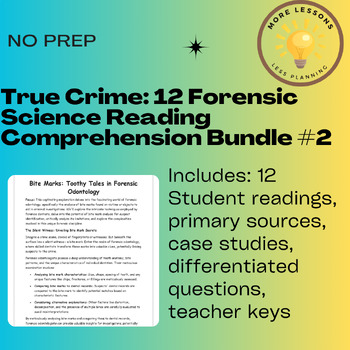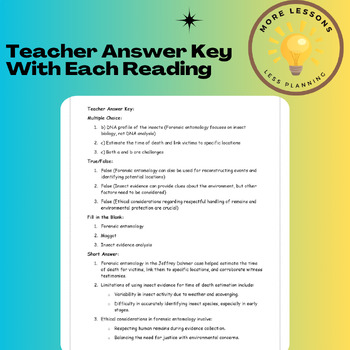The Forensic Files: True Crime Forensic Science Reading Comprehension Bundle
- Zip
Products in this Bundle (12)
showing 1-5 of 12 products
Bonus
Description
The Forensic Files: Unraveling the Mysteries of Crime
Bundle:
Embark on a thrilling exploration of the fascinating world of forensic science with this comprehensive collection of 12 reading comprehension worksheets! Each worksheet delves into a unique forensic discipline, unveiling the intriguing methods used to solve crimes and uncover the truth.
Uncover the secrets hidden in:
- Toxicology: Learn how scientists analyze poisons and drugs to determine cause of death and identify culprits. (e.g., The Alexander Litvinenko case)
- Forensic Psychology: Explore the criminal mind as psychologists assess behavior, evaluate mental states, and aid in legal proceedings. (e.g., The BTK Killer case)
- Footprint Forensics: Discover how podiatrists analyze footprints to link suspects to crime scenes and reconstruct events. (e.g., The Lindbergh baby kidnapping case)
- Brain Clues: Delve into the brain with forensic pathologists to understand cause of death, analyze injuries, and investigate potential crimes. (e.g., The JonBenét Ramsey case)
- Bite Marks: Explore the controversial science of bite mark analysis used for suspect identification. (e.g., The Louise Kennedy case)
- Rocks and Dirt Talk: Witness the power of geology as forensic scientists analyze soil, rocks, and minerals to link suspects and reconstruct crime scenes. (e.g., The Andrea Gail case)
- Insect Detectives: Learn how entomologists use insects to estimate time of death, reconstruct events, and identify locations. (e.g., The Jeffrey Dahmer case)
- Blood Ties: Dive into the world of DNA analysis and its role in identifying suspects, establishing familial relationships, and exonerating the wrongly convicted. (e.g., The Amanda Knox case)
- Plant Power: Explore how botanists analyze plant materials to link suspects to crime scenes, identify geographic origins, and reconstruct events. (e.g., The Polly Klaas case)
- History Unearthed: Travel back in time with forensic archaeologists who analyze burial sites, artifacts, and skeletal remains to solve historical crimes and mysteries. (e.g., The Richard III case)
- Digital Footprints: Unmask cybercriminals as you learn how experts analyze electronic devices and online data to investigate crimes. (e.g., The Silk Road darknet marketplace takedown)
- Ballistics Breakdown: Unravel the secrets of firearms with ballistics experts who analyze bullets, casings, and trajectory patterns to identify weapons and reconstruct shooting scenes. (e.g., The John F. Kennedy assassination)
Engage your students with:
- Informative texts packed with captivating content and real-world case studies.
- Multiple choice, true/false, fill-in-the-blank, and short answer questions to assess comprehension and critical thinking.
- Answer keys for easy grading and self-assessment.
Learning Objectives:
- Students will gain a comprehensive understanding of various forensic science disciplines.
- Students will analyze the techniques and applications used in each forensic field.
- Students will evaluate the limitations and ethical considerations surrounding forensic evidence.
- Students will develop critical thinking and problem-solving skills by applying their knowledge to real-world scenarios.
Recommended Common Core Standards:
- RI.5.1: Quote accurately from a text when explaining what the text says or does.
- RI.5.2: Determine the central ideas or author's purpose in a text.
- RI.5.3: Explain the relationship between a series of historical events described in a text.
- RI.5.7: Draw on information from multiple texts to support a claim or make an inference.
- WHST.5.2: Write informative/explanatory texts to examine a topic and convey ideas clearly.
- WHST.5.4: Produce clear and focused writing on a topic or issue.
- WHST.5.8: Recall relevant information from experiences or texts to explain or support a point.
Ready to unlock your students' critical thinking potential? Explore my store for a treasure trove of reading comprehensions that tackle diverse themes and inspire insightful discussions. From historical mysteries to scientific explorations, there's something for every classroom!
Support a fellow educator and get rewarded! Purchase this resource, leave a review, and earn TpT credits you can use on any product on the platform. Your feedback helps others and benefits you too!
Related Products
- Unleash the CSI in your students! Explore 10 real-life forensic mysteries with this captivating reading comprehension bundle!
- Unleash the detective within your students with this captivating bundle of 12 reading comprehension worksheets that explore the diverse wonders of forensic science!
- Unravel the chilling narratives of history's most





